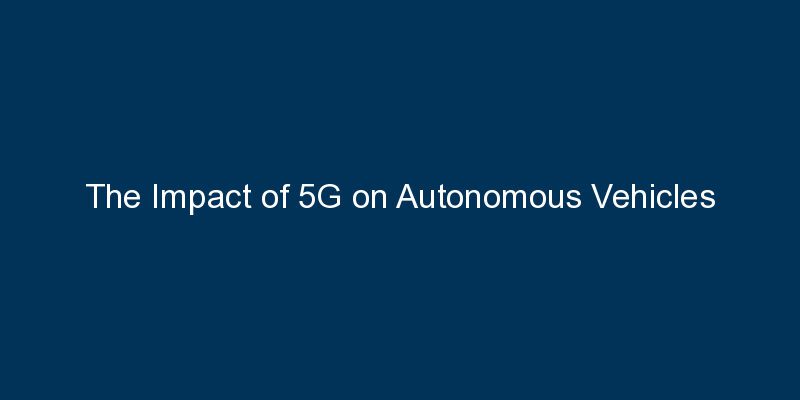In the ever-evolving landscape of technology, the integration of 5G connectivity is set to redefine the capabilities of autonomous vehicles. This blog explores the profound impact of 5G technology on autonomous vehicles, shedding light on the advancements, opportunities, and challenges that arise as we move towards a future where vehicles navigate the roads with increasing autonomy.
Revolutionizing Connectivity for Autonomous Vehicles
Ultra-Fast Communication
One of the key advantages of 5G technology is its ability to provide ultra-fast communication between devices. In the context of autonomous vehicles, this translates to quicker and more reliable data transfer between the vehicle and the surrounding infrastructure. The low latency of 5G ensures near-instantaneous communication, a critical factor for the safety and efficiency of autonomous driving.
Enhanced Data Capacity
Autonomous vehicles generate vast amounts of data from various sensors, cameras, and other components. 5G’s enhanced data capacity allows these vehicles to efficiently process and transmit data in real-time. This high bandwidth is essential for the seamless operation of autonomous systems, enabling quick decision-making and response to the dynamic environment.
Advancements in Vehicle-to-Everything (V2X) Communication
V2X Communication Networks
5G plays a pivotal role in advancing Vehicle-to-Everything (V2X) communication. This encompasses vehicle-to-vehicle (V2V), vehicle-to-infrastructure (V2I), and even vehicle-to-pedestrian (V2P) communication. With 5G connectivity, autonomous vehicles can communicate with each other, traffic lights, road signs, and even pedestrians, creating a comprehensive network that enhances overall safety and coordination on the road.
Intersection Management and Traffic Optimization
Through V2X communication facilitated by 5G, autonomous vehicles can optimize traffic flow at intersections. Vehicles can share information about their position, speed, and intended path, allowing the system to coordinate traffic signals and create smoother traffic patterns. This not only reduces congestion but also enhances the overall efficiency of transportation systems.
Enabling Edge Computing for Autonomous Driving
Decentralized Processing
5G technology enables edge computing, which involves processing data closer to the source rather than relying on a centralized cloud. In the context of autonomous vehicles, this means that crucial decision-making processes can occur within the vehicle itself. The low latency of 5G ensures that data is processed quickly, allowing the vehicle to respond to its environment in real-time.
Enhanced Security and Privacy
Edge computing also enhances security and privacy for autonomous vehicles. By processing sensitive data within the vehicle, there’s a reduced need to transmit extensive personal information to external servers. This decentralized approach minimizes the risk of data breaches and unauthorized access, addressing concerns related to the privacy and security of autonomous driving systems.
Challenges and Considerations in 5G-Enabled Autonomous Vehicles
Infrastructure Deployment
The widespread implementation of 5G infrastructure is crucial for reaping the full benefits of 5G-enabled autonomous vehicles. The deployment of 5G towers and networks needs to be extensive to ensure seamless connectivity, especially in rural and less populated areas. The success of 5G in autonomous driving relies heavily on the availability of a robust and widespread network.
Interoperability and Standardization
Ensuring interoperability and standardization across different manufacturers and service providers is a challenge in the autonomous vehicle ecosystem. To fully harness the potential of 5G, there needs to be a common set of standards and protocols that enable seamless communication between vehicles, infrastructure, and other elements in the transportation ecosystem.
The Future Landscape of Autonomous Vehicles with 5G
Enhanced Safety Features
5G’s low latency and high bandwidth contribute to enhanced safety features in autonomous vehicles. The ability to quickly transmit and receive data allows vehicles to react instantly to potential hazards, reducing the risk of accidents. Features such as collision avoidance systems and emergency braking can benefit significantly from the capabilities of 5G connectivity.
Improved User Experience
5G’s high-speed connectivity transforms the in-vehicle experience for passengers. With the ability to stream high-quality content, participate in video conferences, and enjoy immersive entertainment, the user experience within autonomous vehicles is elevated. This shift towards a more connected and enjoyable travel experience could influence the adoption and acceptance of autonomous driving.
Conclusion
In conclusion, the impact of 5G on autonomous vehicles is transformative, ushering in an era of unprecedented connectivity and capabilities. From revolutionizing V2X communication networks to enabling edge computing and enhancing safety features, 5G plays a central role in shaping the future of autonomous driving.
However, challenges related to infrastructure deployment, interoperability, and standardization must be addressed for the full realization of the potential benefits. As technology continues to evolve, the integration of 5G in autonomous vehicles holds the promise of safer, more efficient, and connected transportation systems, marking a significant milestone in the evolution of mobility.



















Comments